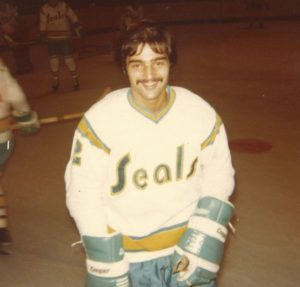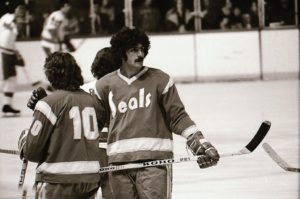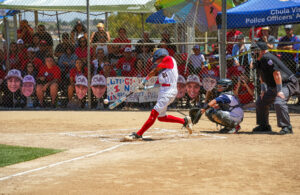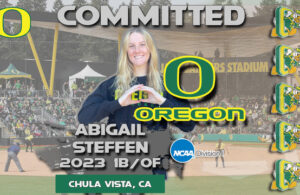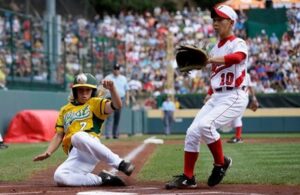Review of “The California Golden Seals Story” Film
- Updated: May 24, 2017
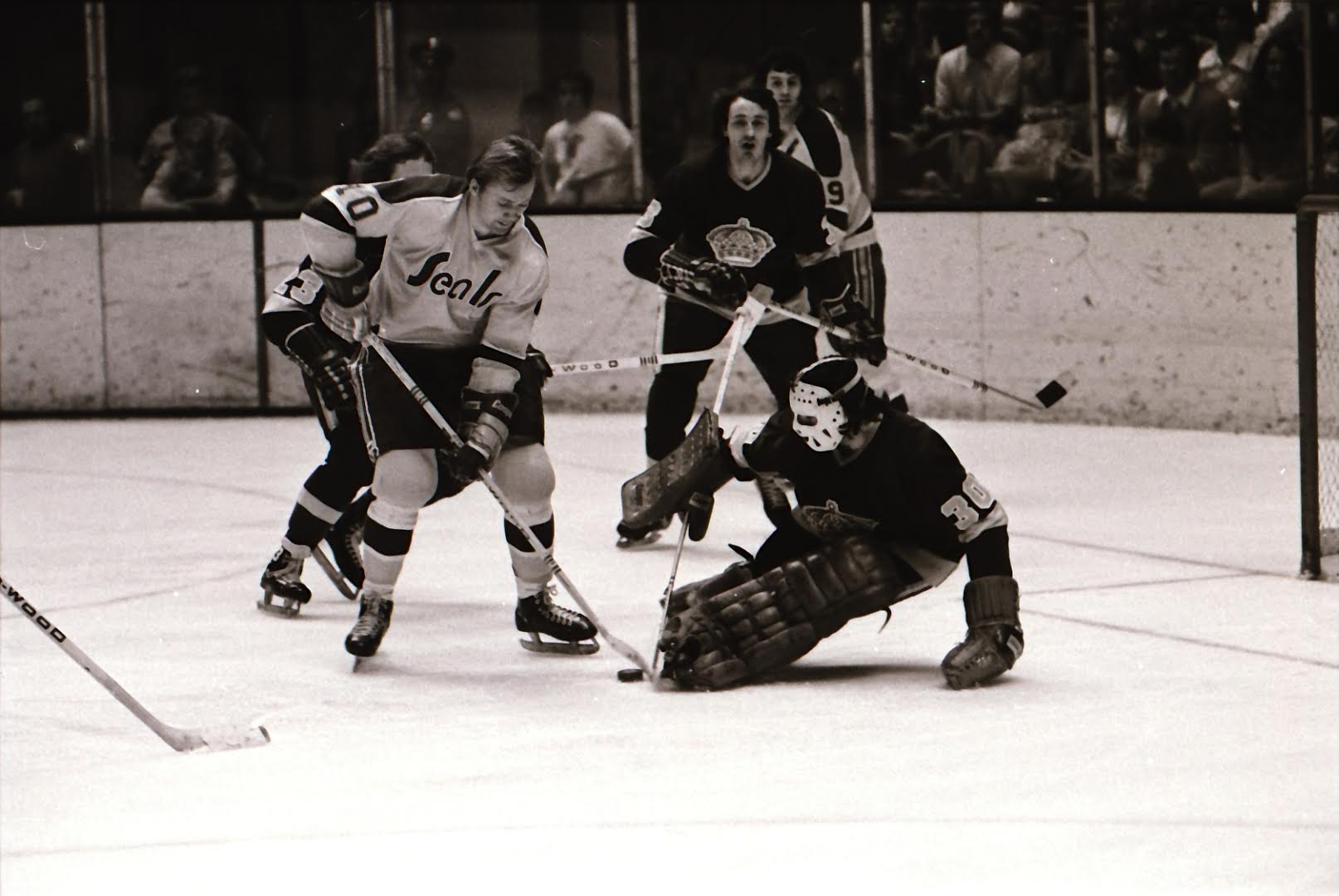
When I was a kid growing up in the 1980’s, I was already fascinated with hockey history and absorbed as much historical information that I possibly could, especially when it pertained to my beloved Los Angeles Kings. One day, I randomly found two old hockey cards hidden inside a vent in my basement, that I assumed were left behind by the previous owners of my house. Already a collector of hockey (and baseball) cards, I marveled (not the Avengers) at my discovery of these two very unique treasures. For one, they weren’t your ordinary NHL hockey cards that I normally collected and was used to from the Topps Company, (known as O’Pee’Chee here in Canada). Instead, one was from the old World Hockey Association (WHA), of defenseman Gordie Roberts of the New England Whalers, (later the Hartford Whalers in the NHL and now the Carolina Hurricanes), and the other was the card of forward Stan Weir of the California Golden Seals. Yes, the Golden Seals. The other original California NHL franchise that had its birth during the same expansion year as the Kings in 1967. But unlike the Kings, by the time I found these cards in the mid-’80’s, the Seals had been long gone and defunct. Even forgotten by many, (like the WHA). At that time, I only knew of the Seals as the first team that the Kings defeated in a playoff series in franchise history, way back in 1969.
Since then, I always found the story of the doomed California Golden Seals/Oakland Seals/California Seals quite fascinating and mesmerizing. Here was a former Kings’ state rival franchise with weird colored jerseys, that had a crazier owner in Charlie Finley, (who was also the owner of MLB’s Oakland A’s), then we had in Los Angeles with Jack Kent Cooke, and that’s saying something! From Finley admitting to the press in his first press conference that he didn’t know “anything about hockey” and other mismanagements, (like Finley foolishly getting rid of Frank Selke jr. and future Hall of Fame builder Bill Torrey), to the player’s wearing bright white skates, or having free games just for barbers, or a paid streaker to streak across the ice just for the media attention, or to trading away their first round draft pick that turned out to be Guy Lafleur, (or could have been Marcel Dionne), or a have a live Seal wobble on the ice, only to fall asleep in front of everyone, and to the team suffering many, many losses, both in the win-loss column and financially, there was still something quite charming about them and their story. Charming and almost mythical in a sense that most of what happened to and with the Seals, a lot of it was just bizarre, almost seems surreal today as if it could have come right out of a movie like “Slapshot”, but in fact, everything actually did happen in real life!
Which is why I was so excited when I came across a great documentary film called “The California Golden Seals Story” on iTunes recently, which covers the Seals’ entire history of the franchise, both on and off the ice, from their humble beginnings as an expansion team, to their “you have to see it to believe their real life craziness and many times odd” nine year existence in the NHL, and right to their fatal end in 1976 after relocating to Ohio to become the Cleveland Barons, who only lasted for two seasons before disappearing themselves after merging with the Minnesota North Stars, (now Dallas Stars). This excellent documentary covers it all, including everything I previously mentioned above and more, with excellent footage, news casts and photos from that era. What was also great about the film and that I really enjoyed was that the film’s director Mark Greczmiel actually interviewed the who’s who of Golden Seal history to tell their perspectives and experiences of playing, coaching or being involved with the original Bay Area franchise, (before there was the San Jose Sharks, there were the California Golden Seals). This includes players like Reggie Leach, (who would go on to win the Stanley Cup with the Philadelphia Flyers in 1975), goaltender Gilles Meloche, (who many believed was the best hockey player in the world at one point, and would have made the Hockey Hall of Fame, if he had instead played for a contender instead of the Seals), Charlie Simmer, (who is best known as part of the legendary LA Kings’ Triple Crown line with Dionne and Dave Taylor, but got his start in the NHL with the Seals before he played with the Kings), and Rick Hampton, who was unfairly promoted by the Seals as “being as good as Bobby Orr,” plus many, many more. Greczmiel even got to interview “The Great One” himself, Wayne Gretzky, who talked about his memories of the Seals while growing up, and former LA Kings’ player and head coach, Hall of Famer Larry Robinson. This hockey documentary leaves no stone unturned, and is brutally honest about the Seals’ history. There is no sugar coating here, but at the same time, the film is also engaging, educating and often times, even hilarious. If you love hockey, or California hockey history, this well made film is a must watch.
Speaking of interviews, I was fortunate enough to get to chat with director Mark Greczmiel about his film and his passion for his childhood team, the California Golden Seals.
What inspired you to create a documentary about the long defunct California/Oakland Golden Seals?
This was a labor-of-love project for me. My family and I are transplanted Canadians who moved from Vancouver to the San Francisco/Bay Area when I was a young child. In 1967, the NHL expanded from six to twelve teams and the newly-created California Seals started playing at the Oakland Coliseum which was a ten-minute drive from our house. My dad took my brothers and I to see the Seals vs. the Leafs, and my older brother caught a puck at that first game. I was nine years old and we kept going to games throughout the team’s nine seasons in Oakland. I later began a career in TV news and produced a couple of stories about the Seals history. I always thought their story would make for an interesting documentary, but didn’t pursue it until three years ago. I’ve been living in Los Angeles since 2000, and normally work as a documentary producer on shows like “True Hollywood Story” and various entertainment specials. I was in-between gigs and after reading a wonderful book about the Seals by Brad Kurtzberg titled, “Shorthanded,” I decided to go for it.
As a child and a fan, what were your fondest memories of watching the Seals play?
There were many. I remember the camaraderie of the section that we normally sat in, and how our fellow fans would greet us when we arrived. I remember cheerleader “Krazy” George electrifying the crowd by pounding on his drum. I know we lost more games than we won, but it was such a thrill when the Seals staged the occasional upset by beating far-better teams like Montreal and Boston. Of course it was also a huge thrill to see players like Bobby Orr, Phil Esposito, Bobby Hull, and Gordie Howe. I also vividly remember the night that a female streaker dashed across the ice right before the start of a period. The financially challenged Seals promotions team had hired the girlfriend of the stick-boy to stage the stunt in order to generate publicity. It was very successful in getting the team news coverage. Not only do I have a photo of the streaker in the film, I was also able to dig up some old Super 8 film of her making her short skate across the ice.
Speaking of cheerleader “Krazy” George and his drum, (think Bailey), who you got to interview in the film, he seems like quite the energized and passionate character. Could you tell us more about him and how important he turned out to be for the fans and Seals’ franchise?
George Henderson was a high school teacher who came to one game with a group of students and electrified the crowd with his antics which included running madly through the crowd, and pounding his drum just inches from the heads of unsuspecting players. One of whom chased him into the stands.* He was so popular that the Seals quickly hired him to keep coming to games! The St. Louis Blues saw how popular he was and tried to hire him away. After the Seals left Oakland, he signed a contract with the new Denver NHL team, (Colorado Rockies, now New Jersey Devils). He quit his teaching job to become a professional cheerleader – something he still does at age 70-plus.
*(The player that chased “Krazy” George into the stands was former Boston Bruins’ player and head coach, Terry O’Reilly).
The Seals entered the NHL as an expansion team at the same time that the Los Angeles Kings’ did for the 1967-68 season. The Kings of course are still around and survived some serious obstacles in those pioneering early years, but sadly the Seals did not. If you had a time machine, and you could go back to redo something, or some things to help the Seals survive, when and where would you travel to and what would you change, or do differently to help save the Seals?
I would go back to 1970 when the struggling Seals filed for bankruptcy and were for sale. Two people wanted to buy the team: Oakland A’s owner Charlie Finley, who famously told people that he had only seen one hockey game prior to pursuing the Seals, and another gentleman named Jerry Seltzer. I interviewed Jerry for the film. He was a master promoter based in the Bay Area, and whose family had created roller derby and made it a big success across North America. He had teamed up with the owners of some AFL football teams and created a 100-plus-page document detailing how they would run, promote, and market the team. They presented it at a meeting with NHL officials. Meanwhile, Finley only had a one-page proposal, but he schmoozed the other owners and wound up getting the franchise. Seltzer felt that it was because the NHL looked down at roller derby and didn’t take him seriously. Unfortunately, the league soon came to regret their decision as they battled Finley’s enormous ego and often-bizarre decisions. The hockey people running the team before “Charlie O” bought the franchise included Frank Selke jr. and Bill Torrey. Under them, the Seals had reached the playoffs for two straight seasons but sadly, both men were quickly forced out by Finley, who wouldn’t honor their contracts. Torrey went on to the New York Islanders, where he built a Stanley Cup-winning dynasty, (four Stanley Cup victories in a row from 1980 to 1983 in five straight Stanley Cup Final appearances). The Seals would never again make the playoffs.
The only death that is NHL “on the ice” related happened during the Seals first season in a game against the Minnesota North Stars in Minnesota. Tragically, Stars’ player Bill Masterton passed away due to an on ice incident, and now has a trophy named in his honor today for the player who best exemplifies the qualities of perseverance. Could you take us back to the incident and explain to us what exactly happened?
I interviewed three people who were eyewitnesses to that tragedy: Seals players Gary Smith and Bert Marshall, and the team’s PR director/radio announcer Tim Ryan. They described how Masterton was bringing out the puck and tried to split two Seals players. The pair combined to stop Masterton in what was a perfectly clean hit. Sadly, the Minnesota player fell backwards and hit his head on the ice. Like most players of that time, he wasn’t wearing a helmet. Ryan described hearing the sound of Masterton’s skull hitting the ice. Smith remembered skating over and being told by the team doctor, “It doesn’t look good.” It was clear that everyone who witnessed that tragedy would never forget it.
The Seals struggled with attendance for most of their existence. What could have helped the Seals improve that? Would drafting a talent like Guy Lafleur, (or Marcel Dionne), instead of trading away his draft spot, have made a stronger impact for the fans and team?
I’m not sure if getting Lafleur would have made a huge difference. The team suffered from poor coaching for a number of seasons and that might have worn down Lafleur like it did another superstar who did play for the Seals – Reggie Leach. Regarding attendance: winning is always a good remedy for improving the crowds, but sadly that didn’t happen often enough. I have to point out that even though sometimes the attendance would only be around 3,000, the fans always made a lot of noise and were very loyal.
Owner Charles Finley attempted many “outside of the box” marketing ploys, from the players using white skates and orange pucks and as you mentioned earlier, to hiring someone to streak across the ice, etc. What are some other wild marketing stunts that Finley attempted, and for all of his faults and mistakes, was there anything positive that Finley did bring to the Seals and the NHL?
The Polar Bear white skates are what the team will always be best remembered for. Finley insisted that they be spotless, and made the trainers re-paint them often to hide the scuff marks. The players complained that as the season went on, the skates would get heavier and heavier. One of Finley’s other innovations was to put the players names on the backs of their jerseys. He received push back from some NHL owners, who feared that would cut into their ticket sales, and they wouldn’t let the Seals wear those jerseys at their arenas so the team had to travel with two sets uniforms – one with the names, and one without. And despite being cheap in so many ways, Finley did insist that his players fly first class when travelling cross country. Back then, professional sports teams usually flew coach and went on regular commercial flights, not charters.
One strange marketing move that the Seals made was when they over-hyped their acquisition of defenseman Rick Hampton, by marketing him as being as “good as Bobby Orr.” In the end, he wasn’t even close, but why do you think the Seals attempted to promote him as such, and why the rookie Hampton exactly?
With a change in the draft rules, the Seals used their first, first-round draft choice in a number of years to get the then-17-year-old Rick Hampton. The franchise was desperate to prove they were turning things around, and heavily hyped him as the next Bobby Orr. That put him under intense pressure. Also, Hampton signed a huge contact which made a lot of the veteran players jealous. It was a lot for a teenager to deal with. If he had been nurtured along, and perhaps played in the minors first, he might have reached his full potential. He was one of the best interviews I conducted and was brutally honest about the ups and downs of being with the Seals.
The NHL suffered as a whole when the World Hockey Association was formed as a rival league in the early 1970’s. How did the formation and competition of the WHA effect and hurt the Seals?
The Seals had just missed the playoffs the year before, and everyone was very confident that they were going to have a great season. Unfortunately, Finley would not budge on increasing salaries to counter the very generous offers that the players were getting from the new WHA teams. Goalie Gilles Meloche told me that Finley predicted the new league would go belly up by Christmas, and that the defectors would be begging for their jobs back. That didn’t happen. The Seals lost nine players, including a number of their top scorers to the WHA. They lost more players than any other NHL team and quickly went into a tail spin. Part of the documentary deals with how the Seals’ general manager was so desperate to stop the exodus, that he devised a scheme where they signed duplicate contracts for different salaries. He would only show Finley the ones with the lower amounts.
LA Kings’ legend Charlie Simmer was a popular and successful member of the Kings’ most famous line, the “Triple Crown” line, alongside Hall of Famer Marcel Dionne and Dave Taylor. What some Kings’ fans may not know, is that Simmer played on an NHL California team before the Kings, which of course was the Seals. Why do you think Charlie Simmer’s time in Oakland wasn’t as successful as it would later turn out to be in LA?
I interviewed Charlie up in Calgary. He was with the Seals during their final two seasons in Oakland, and he actually had trouble staying with the club that last year. He confessed he got a little lazy after a successful rookie season and showed up a bit out of shape for training camp. He was sent to the minor league team in Salt Lake City, but was often called up when the Seals played tough teams like Philadelphia and Boston, as some of his teammates would come down with a suspicious case of the flu before those rougher games. Charlie did mention that the team often suffered from a losing attitude which was difficult to pull out of.
Can you tell us about the Seals Booster Club and how important they were to the fans and to the franchise at the time?
All the players spoke about how appreciative they were of the Booster Club’s support. The documentary has photos and film of the players attending awards ceremonies and picnics. The Seals Booster Club still meets every other month – more than 40 years after the team left. I shot one of those meetings and that’s in the film.
You impressively interviewed a long list of former Golden Seal players and personnel for this documentary, and even spoke with Wayne Gretzky and Larry Robinson for it as well. How were you able to contact and find all of them, and were there any players, or coaches that you weren’t unfortunately able to find or get to interview?
I was fortunate enough to interview more than 30 former players, team officials, journalists and fans. Wayne Gretzky was a “Hail Mary” request, and he graciously agreed to sit down. I contacted his office because I had read that the first NHL game No. 99 ever saw in-person was a Seals game against the Maple Leafs at the old Maple Leaf Gardens. He told that story, and was also well-versed in the history of the team. As a kid, he was friends with the families of two California Seal players, and spoke about their legacy to the game of hockey. Gretzky did comment that when he first saw the team’s infamous white ice skates, he said to himself, “If I make it to the NHL, I hope I don’t have to wear white skates!”
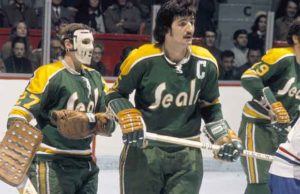
(Carol Vadnais, photo credit to nhl.com)
I had a wish-list of players I wanted to interview and I checked off nearly everyone. One player that I sadly was not able to get was the great Carol Vadnais, who was the team’s first real star. He was ill when I spoke to him on the phone, and he told me that he wanted to sit down, but wished to get over the hump with his illness. He passed away a few weeks later from cancer.
In 1976, due to the collapse of a deal between the Seals owner Mel Swig and the mayor of San Francisco at the time, George Moscone, over the building of a new state of the art arena for the Seals to play in San Francisco, the Seals were relocated to Richfield, OH, and became the Cleveland Barons, before merging with the Minnesota North Stars. After having the agreement for the new arena made, why did the mayor of San Francisco back out of the deal at the last second? And would the Seals still be around today if he hadn’t?
The new mayor wasn’t a fan of the arena, or the deal that Swig had made with the previous mayor – Joseph Alioto. When Moscone took office, more studies were ordered and the entire thing fell apart. The Oakland Coliseum at that time only held 12,500 fans, and was too small to financially support an NHL franchise. Perhaps the Seals would still be in the Bay Area today if they got that new arena. Things were certainly looking up during the 1975-76 season. They had a more effective and stable owner in Mel Swig, and the team enjoyed their best season in years with a steadily-climbing attendance.
As a fan, once the Seals had relocated to Ohio, and then merged with Minnesota, did you continue to watch and follow hockey? If so, what team did you start following then, and are you a San Jose Sharks supporter now?
I actually transferred to UCLA for the 1978-79 school year, and as a Film/TV major, got an internship for a TV company that broadcasted LA Kings’ hockey games. I went to many games at the Forum where my job was to drag camera cables and various other gear. After graduation, I started my TV career up in Edmonton, just in time for the Oilers incredible run with Wayne Gretzky. I still remember the heartbreak of the “Miracle on Manchester.” I later moved back to California, and worked in TV news in Sacramento. I produced a number of stories about the start-up of the Sharks franchise and I very much feel that some of the Seals’ DNA still lives on with San Jose.
12 years after the Seals were gone, Wayne Gretzky arrived in California to play for the Kings, and created an explosion to the hockey world, which led to more expansions for the NHL in the southern belt of the United States. Former Seals’ owners, The Gund brothers, secured the rights to the next California expansion team, which became the San Jose Sharks. In those early years for the Sharks, what did the Sharks do right, or opposite of what the Seals did, that helped that young franchise survive in an area that the Seals originally struggled with?
When I produced the news stories about the start-up of the Sharks, I was so impressed with how well-thought-out their game plan was for selling the sport in the Bay Area. They did a wonderful job with promotions and community outreach. The fact that the South Bay now had the Silicon Valley and all that money didn’t hurt either. Plus the team had an excellent GM with Dean Lombardi, who later helped bring a couple of Stanley Cups to Los Angeles.
Well thank you Mark for doing this interview and for your time. I really did enjoy your documentary immensely, and do highly recommend it to anyone that enjoys hockey, NHL and California hockey history. It was so well done.
Thanks so much Jeff. As mentioned, this was a passion project for me. I raised money through a couple of crowd-funding campaigns that had a side effect in that people heard about the film, and then contacted me with old instamatic photos from Seal’s games, as well as wonderful Super 8 home movies. A number of photographers and NHL teams gave me photos free of charge. Finding footage was a real detective hunt, and I located some old 2-inch videotapes with broadcast footage of various games. I also tracked down a variety of 16mm news stories that had sat – unseen – on shelves in a warehouse for four decades. Some of that footage included highlights from the 1969 playoff series between the Kings and Seals that LA won in seven games. The film was incredibly satisfying for me to make. I did it on a shoe-string budget which required me to both shoot and conduct the interviews by myself. I travelled across Canada and the U.S to get this done, and along the way got to know the players I grew up idolizing as a kid. I would not have missed going on this adventure for anything.
“The California Golden Seals Story” is a great, entertaining watch and highly recommended by me, so make sure to check it out! The film is available on iTunes at this link: https://itunes.apple.com/us/movie/california-golden-seals-story/id1189538880
Stay with us at Calisportsnews.com as we will keep you up-to-date on all things Los Angeles Kings and the rest of the LA sports teams! All Cali, all the time!





